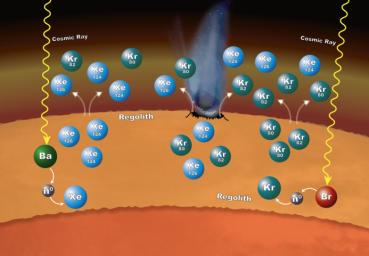
|
Isotopic Clues to Mars’ Crust-Atmosphere Interactions
- Click the image above for a larger view
- Full-Res JPEG (1280 x 888) (92.7 kB)
- Full-Res TIFF (1280 x 888) (1.9 MB)
Caption:
Chemistry that takes place in the surface material on Mars can explain why particular xenon (Xe) and krypton (Kr) isotopes are more abundant in the Martian atmosphere than expected.
The isotopes -- variants that have different numbers of neutrons -- are formed in the loose rocks and material that make up the regolith -- the surface layer down to solid rock. The chemistry begins when cosmic rays penetrate into the surface material. If the cosmic rays strike an atom of barium (Ba), the barium can lose one or more of its neutrons (n0). Atoms of xenon can pick up some of those neutrons -- a process called neutron capture -- to form the isotopes xenon-124 and xenon-126. In the same way, atoms of bromine (Br) can lose some of their neutrons to krypton, leading to the formation of krypton-80 and krypton-82 isotopes. These isotopes can enter the atmosphere when the regolith is disturbed by impacts and abrasion, allowing gas to escape.
The Sample Analysis at Mars (SAM) laboratory suite inside NASA's Curiosity Mars rover has measured the isotope ratios of xenon and krypton in Mars' atmosphere.
Background Info:
Development of SAM was coordinated by NASA's Goddard Space Flight Center, Greenbelt, Maryland. NASA's Jet Propulsion Laboratory, a division of Caltech in Pasadena, California, manages the Mars Science Laboratory Project, and built the project's Curiosity rover, for NASA's Science Mission Directorate, Washington.
Cataloging Keywords:
| Name | Value | Additional Values |
|---|---|---|
| Target | Mars | |
| System | ||
| Target Type | Planet | |
| Mission | Mars Science Laboratory (MSL) | |
| Instrument Host | Curiosity Rover | |
| Host Type | Rover | |
| Instrument | Sample Analysis at Mars (SAM) | |
| Detector | ||
| Extra Keywords | Atmosphere, Color, Impact | |
| Acquisition Date | ||
| Release Date | 2016-09-29 | |
| Date in Caption | ||
| Image Credit | NASA/GSFC/JPL-Caltech | |
| Source | photojournal.jpl.nasa.gov/catalog/PIA20847 | |
| Identifier | PIA20847 | |
